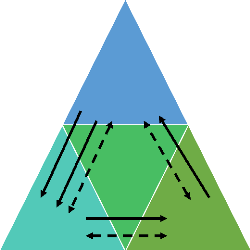2.2. AVCF definition
There is still no unified definition of AVCF. Different
authors show an understanding with various characteristics on this subject.
However, one of the most widely accepted definitions is the one formulated by
Miller and Jones (2010), who define value chain finance as:» the flows of
funds to and among the various links within a value chain" and distinguish
between internal and external value chain finance. Likewise, authors from FAO
and AFRACA (2020) defined AVCF as two internal flows of financing between chain
actors directly within the VC and for financial service providers who use AVCF
to lend money or to invest in one or more of the chain actors. However, the
authors of KIT and IIRR (2010) have defined the VCF triangle, in which FI
engages with the actors of the chain. This triangle is among FI, the seller and
the buyer. The figure below illustrates the VCF.

Seller
financial institution
VCF
triangle
Buyer

10
Figure 4: Overview of value chain finance Triangle
Source: KIT and IIRR (2010)
This figure shows the payment, loan, and information and
services flows between the financial institutions and the seller. Additionally,
the payment and information flow between buyer and FI. Eventually, the flows of
information and services and product between the buyer and the seller.
Complementarily, a study by Carroll et al. (2012) provides a
pragmatic definition of AVCF:
...in the case of agriculture, the value chain may include
(but is not limited to) input provision, production, processing, transport,
storage marketing, and export.
Additionally, the Asian Development Bank (ADB) (2012) makes the
definition of AVCF simpler:
...organized linkages between groups of producers, traders,
processors, and service providers (including nongovernment organizations) that
join together to improve productivity and the value-added from their
activities.
Similarly, Zander (2016) presented the following
definition»:
Value chain finance (VCF) denotes all financing arrangements
within a specific value chain or from outside the chain. As the concept of
value chains and their financing is broad and multifaceted, the terms `value
chain' and `VCF' necessarily refer to a broad range of different instruments
and mechanisms.
Finally, a recent study by Villalba, Venus, & Sauer (2021)
explains Agricultural Value Chain Finance (AVCF) as:
A variety of products and approaches that allow stakeholders
from a value chain to leverage social capital and satisfy the funding needs of
the weakest actors. Cooperating within a value chain reduces risk, which can
facilitate the

11
acquisition of financing from financial institutions, and other
lenders at a lower
cost.
While no common definition has been proposed in the
literature, ADB (2012) and Carroll et al. (2012) have the constituting element
«provision», «processing», and «productivity» in
common. They show that the chain starts from the raw material stage to the
final consumer. However, other researchers explain this term as a variety of
different products, mechanisms, and instruments used by different actors in the
chain to initiate financing arrangements (Villalba, Venus, & Sauer, 2021;
Zander R. , 2016).
There is agreement between the literatures when it comes to
the flows of funds. (Miller & Jones, 2010; KIT and IIRR, 2010; AFRACA and
FAO, 2020). In addition, there are definitions of AVCF for which the authors
partially agree such as internal and external value chain (Miller & Jones,
2010; AFRACA and FAO, 2020).
The authors agreed that Internal Value chain finance takes
place within the value chain such as when an input supplier provides credit to
a farmer, or when a lead firm advances funds to a market intermediary. External
value chain finance is that which is made possible by value chain relationships
and mechanisms: for example, a bank issues a loan to farmers based on a
contract with a trusted buyer or a warehouse receipt from a recognized storage
facility.
Other authors defined AVCF as a triangle, in which, an
agreement between the actors (FI, seller and buyer) is made around the product,
the need for financing, the sharing of information, the method of
communication, and finally the way of risk management (AFRACA and FAO, 2020).
This agreement according to KIT and IIRR (2010) allows the development of the
value chain in three different ways:
a) Ensuring liquidity for the actors of the chain
b) Creation of new chains
c) Investments in existing chains
This highlights how general financing of agriculture works,
(new investments, reinvestments, and financing of current assets) and is a
useful typology for value chain development.
| 


